Menu
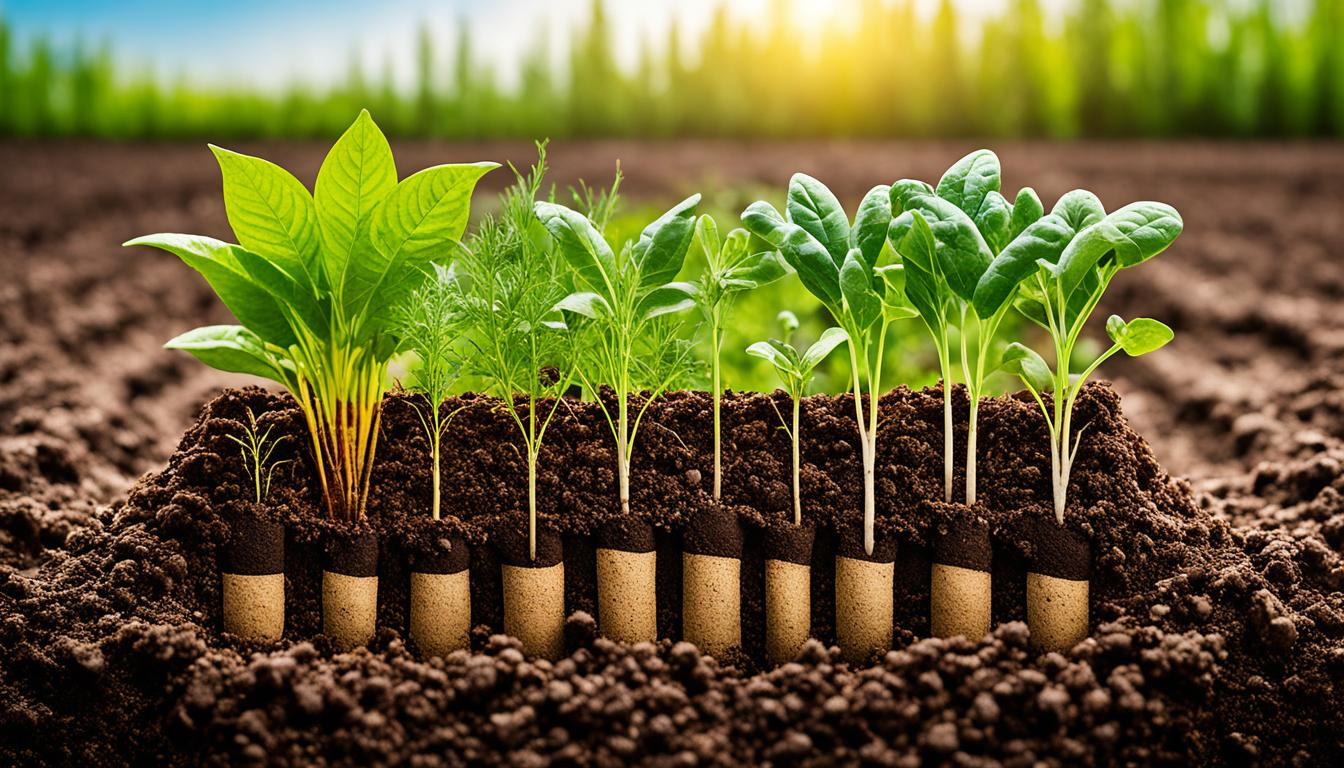
Did you know that most farm soils have more than half of their helpful microbes asleep? They are not active because they don’t have enough food. Soil health indicators show us how well the soil can support life and protect the environment. They include things like soil colour, structure, and the life in the soil known as biological activity. These indicators tell us a lot about soil quality. They influence things like how well plants grow, the homes for animals, and how water moves through the ground.
Soil health indicators cover many aspects like physical, chemical, and living organisms. They give us a full view of soil quality. Knowing about these indicators helps us see how the soil works in nature. It is key for keeping the soil productive, fertile, and safe. By watching and working on these factors, we can make soil better and keep the environment balanced. This is important for long-term farming.
Soil health indicators are key to understanding soil’s condition. They cover its structure, chemistry, and activity. This knowledge is essential for farming in a sustainable way, helping to boost soil productivity. They check soil nutrients, structure, microbe activity, and pH to see if the soil can support crops well without harming the environment.
Soil health indicators show us if soil can grow crops or provide other benefits. They look at soil productivity, structure, and nutrients. For instance, checking soil microbes and pH levels gives clues on how nutrients move and what services they provide.
“The 500 Soils program in New Zealand tested various indicators including total carbon, nitrogen, bulk density, soil respiration, microbial biomass, and nutrient content like Olsen P,” showing the complex approach needed for soil checking.
Using these indicators, farmers can make smart choices. This helps manage soil well and make farming productive without hurting the land.
Before, we mainly cared about the physical and chemical sides of soil. But, the Dust Bowl in the 1930s made us realise we also need to look at the biological part. This big event showed us we must farm in ways that keep the soil healthy for the long term.
Now, we have detailed projects checking 31 different indicators across North America. This shows how different aspects of soil health are important to keep our soil strong.
Learning about the past and many indicators helps farmers today. It enables them to take care of the soil in a complete way, which is crucial for food and environmental safety.
The physical properties of soil are key to its health. They include texture, structure, water holding, and infiltration. These affect soil function and how productive it is. These elements help us understand the state of soil.
Soil texture is about sand, silt, and clay amounts. It impacts water holding and nutrient use. For example, sandy soil lets water pass through quickly, but clay retains water. Soil structure is how these particles are arranged. Good structure enhances water flow and air, benefiting roots and microbes. Adding organic matter and reducing soil disturbance improve soil structure.
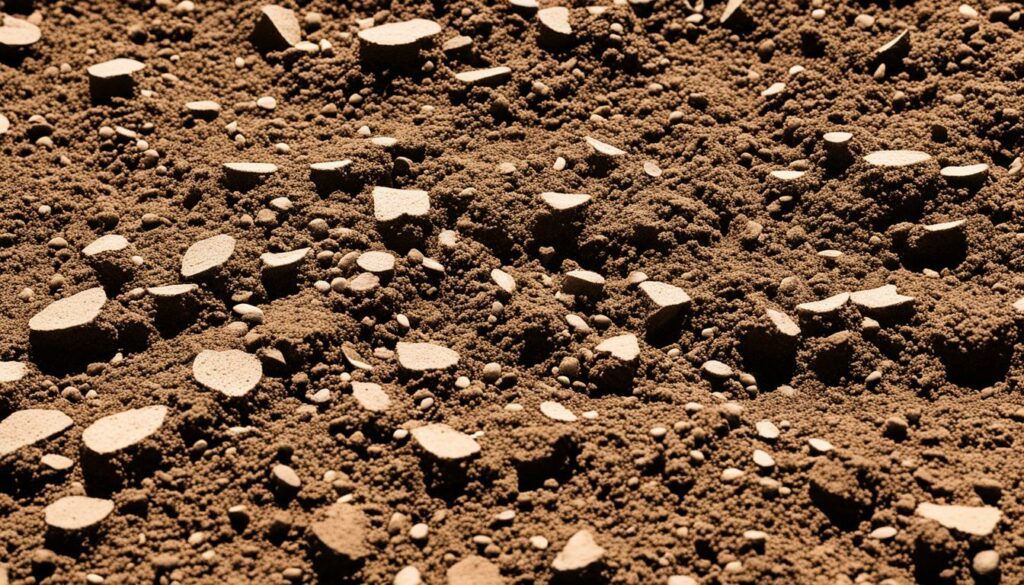
How well soil holds water is crucial for plants. More organic matter means better water retention. Infiltration is about how fast water gets into the soil, stopping erosion. These link to soil consistency and farming success. Techniques like planting cover crops improve both water holding and soil quality.
The chemical properties of soil are key to understand its soil chemical composition. This helps find out if it can support plant growth. The pH level of soil shows how acidic or basic it is. A pH of 7 is neutral. pH 5 is much more acidic than 6 or 7. The pH level affects how plants can use nutrients and where certain minerals move in the soil.
Reactive Carbon (RC) matters a lot and stays in soil for 2 to 5 years. It’s from parts of soil organic matter. Electrical Conductivity (EC) tells us how well soil water can let electricity through. This is because of the pores filled with water. If soil is not treated correctly, it might get too acidic over time. This can really hurt plant nutrient uptake.
“Understanding specific soil chemical properties allows for better nutrient content analysis and informed decision-making in agricultural practices.”
Things like CEC, base saturation %, and ESP are good for checking soil quality. But to measure them, you usually need a lab. Real-field conditions can vary a lot in terms of pH, EC, and the levels of nitrogen and phosphorus. So, taking lots of samples is crucial for figuring out the true soil fertility.
Irrigating with salty water can make soils too salty. This shows up in EC levels. Some indicators, like soil pH, can be checked right in the field. Knowing about these soil properties helps choose the best ways to fertilise and treat soil. This makes it better for growing crops.
| Chemical Property | Description | Impact on Soil Health |
|---|---|---|
| pH Level | Scale from 0 to 14 indicating acidity or alkalinity | Affects nutrient solubility and microbial activity |
| Electrical Conductivity (EC) | Measures soil water’s ability to carry electrical current | Indicates soil salinity and nutrient levels |
| Reactive Carbon (RC) | Derived from soil organic matter with a 2-5 year residence time | Influences soil structure and fertility |
| Nutrient Content (N, P, K) | Essential elements often deficient in soils | Critical for plant growth and reproduction |
It’s really important to look at these chemical properties closely for a full soil fertility assessment. This helps in deciding the best fertilisation and treatment. The aim is to boost crop yield.
The health and plant growth in soil depend on its biology. This includes how nutrients move, diseases are kept in check, and the soil’s general structure.
Microbes in the soil are key for its health. They help with moving nutrients, keeping carbon (that’s good for plants) as well as breaking down old plants and animals. Today, we use special kinds of fats and DNA to check how active they are. Did you know, a pinch of good soil can have hundreds of different microbes? This shows how many are living there.
But, changing how we manage the land can change these microbe communities. Tilling the soil too much or adding lots of chemicals can make the good bacteria go away. Also, too much salt can make the soil unhealthy for tiny creatures living there.
Big soil creatures like earthworms and insects are also very important. They are easy to see and they do a lot for the soil. For example, earthworms help to mix the soil and add nutrients. It’s why you often hear about how good they are for gardens.
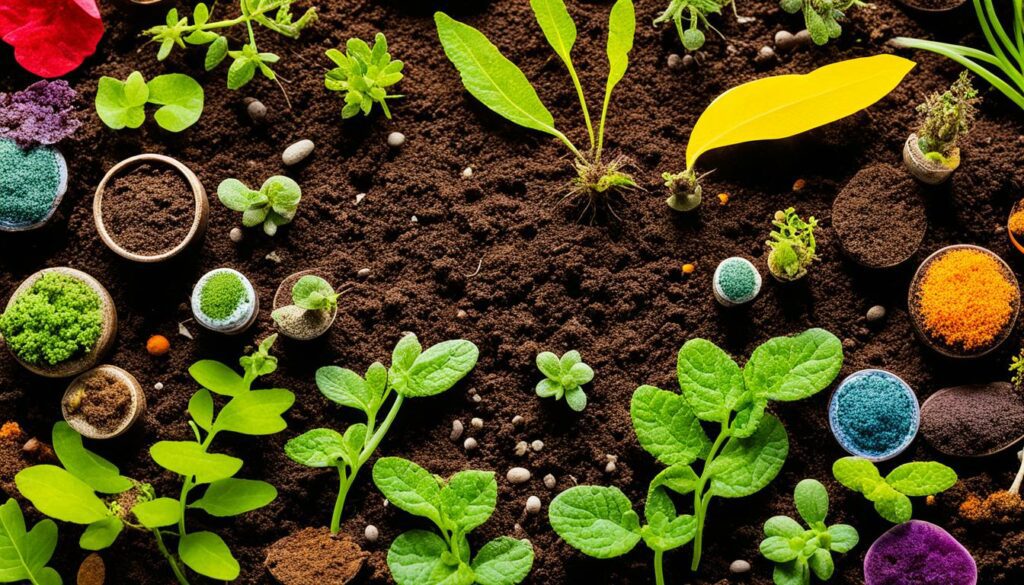
| Indicator | Function | Stress Factors |
|---|---|---|
| Microbial activity | Nutrient cycling, carbon sequestration | Soil acidification, high salinity |
| Earthworm population | Improved soil structure, nutrient availability | Tillage, residue management |
Farming in ways that don’t harm the soil, like changing what you plant each year, can make it richer. This is good for a mix of good fungi and bacteria. Having a lot of healthy soil life, big and small, makes for strong and fertile farms.
The pH of soil shows if it’s acidic or alkaline. Knowing this helps manage the soil better. Most plants like a pH of 6.0 to 7.5 for good growth and to take in nutrients well.
Soil pH measures how much acid or alkali the soil has. A pH below 7.0 is acidic, higher is alkaline. Soil can have a pH from 4.7 to 7.5. This affects the type of crops that grow best, such as wheat and corn doing well at pH 5.6-6.0.
Soil pH can be Ultra Acid, Extremely Acid, or Neutral. Knowing these levels helps adjust the pH for different plants. You need soil probes, calibrated vials, and pH test trips for accurate checking.
Key nutrients like phosphorus change a lot with soil pH. They’re best between pH 6.0 and 7.5. The Mehlich buffer test is great for checking these levels. Right pH helps friendly microbes grow, improving nutrient use by plants.
| Soil pH Level | Description | Optimal Crop Yield Range |
|---|---|---|
| 4.7 – 5.3 | Extremely Acid | Lower yields for most crops |
| 5.4 – 6.0 | Moderately Acid | Optimal for wheat, corn |
| 6.1 – 7.0 | Slightly Acid to Neutral | Optimal for most crops |
| 7.1 – 7.5 | Slightly Alkaline | Varies by crop |
It’s key to keep soil pH right by using lime or organic material. Doing this helps plants take in nutrients well, boosting their health and how much they produce.
Understanding soil nutrient levels is key to knowing what plants need to grow healthily. Testing soil often helps in making sure plants get the right nutrients to grow well.
Plants need macronutrients like nitrogen (N), phosphorus (P), and potassium (K) for growth. Nitrogen helps their leaves, phosphorus their roots and energy, while potassium boosts their overall health and fights off diseases. By checking and adjusting these nutrients with organic matter and fertilisers, the soil stays fertile for good crop growth.
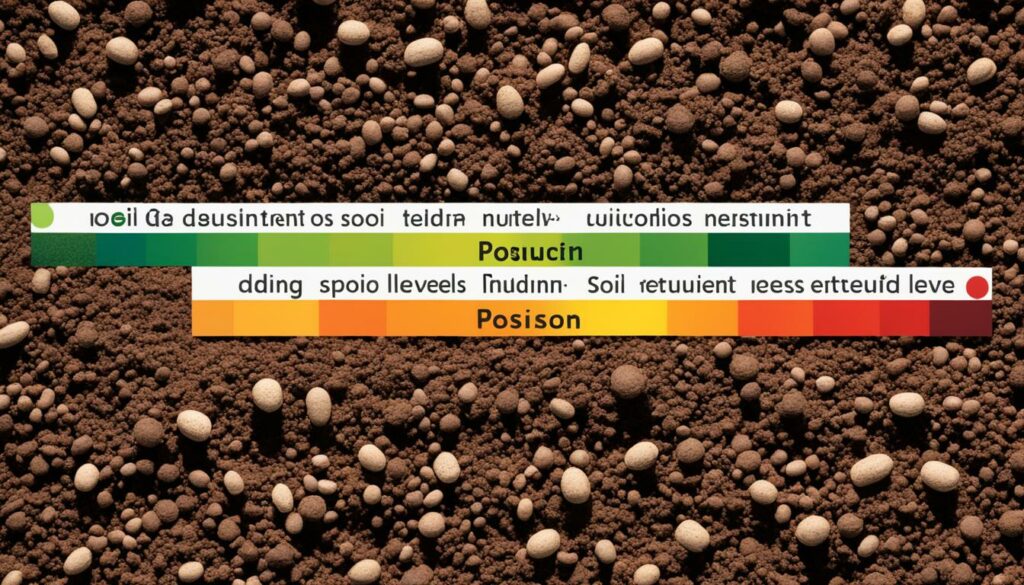
Although plants need less of them, micronutrients are still very important. For example, iron, manganese, zinc, copper, and boron are crucial for plant health. Regular soil tests uncover any micronutrient shortages. This lets farmers act quickly with the right fertilisers to improve their crops.
Managing soil nutrient levels through regular testing is essential for healthy plant development. For more on how to check soil health, see this detailed guide.
Soil salinity is a big deal for soil health. Too many soluble salts make it hard for plants to get enough food and water. This leads to small growth and poor crops. It’s important to check salt levels in the soil to manage it well.
Saline soils have high salt content, measured by EC, of >4 dS/m. This means there’s a lot of salts in the soil water. Some plants like peaches can’t handle this much salt. But others like cotton can.
EC and TSS have a simple link. More EC means more TSS, which shows how much salt is in the soil. You can use this to figure out the soil’s sodium chloride levels.
For better soil care, focus on EC, SAR, and ESP. EC > 4 dS/m and ESP over 15% is bad for some plants. These facts help manage salty soils and protect crops.
High soil salinity affects a fifth of farming lands worldwide. It stops plants from growing well, lowering food output. This hits human health and jobs hard. To fight salt, use gypsum and choose crops that can take it. Good drainage is also key.
| Soil Type | Electrical Conductivity (dS/m) | Exchangeable Sodium Percentage (ESP) |
|---|---|---|
| Normal Soil | ||
| Saline Soil | > 4 | |
| Sodic Soil | > 15 | |
| Saline-Sodic Soil | > 4 | > 15 |
Soil organic matter is key for keeping soil healthy and productive. It acts as a store of important nutrients, which helps plants grow well. It’s made up of old plants and animals. This adds to the soil’s structure and helps keep water in. It also stores carbon deeply in the ground.
Organic matter in the soil is very important. It’s crucial for the soil to be the right colour and have a good structure. Soil that’s dark is usually full of organic matter. This tells us it’s rich in nutrients and holds water well. Organic matter keeps the soil particles together. This makes room for air and water, and it lets helpful insects and earthworms live there.
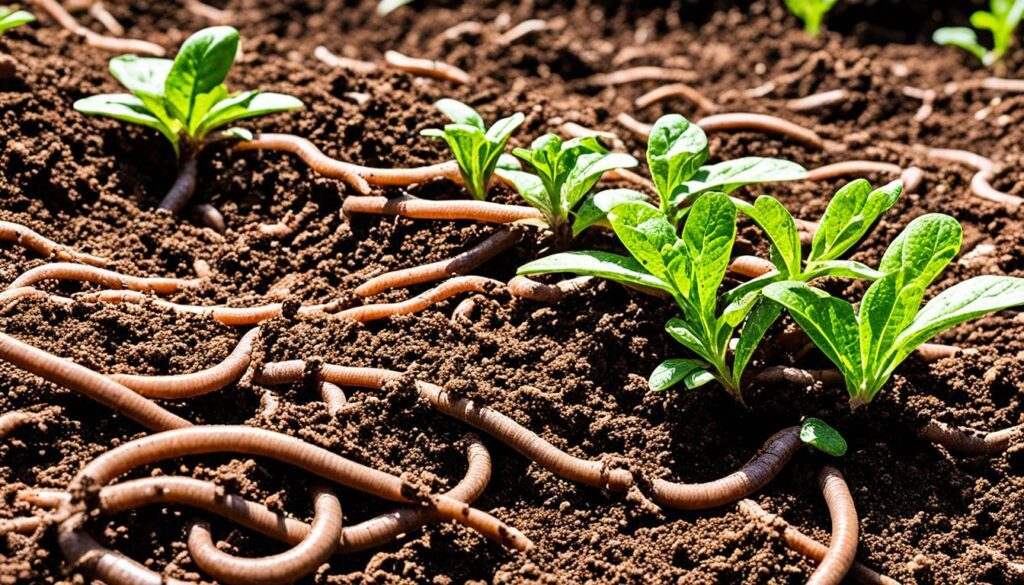
| Indicator | Impact of Organic Matter |
|---|---|
| Soil Cover | Prevents erosion and promotes ecosystem health |
| Soil Colour | Darker soils indicate higher organic matter content |
| Soil Structure | Improved aggregate stability and increased water infiltration |
| Biological Activity | Supports beneficial organisms like earthworms and dung beetles |
| Rooting Resistance | Reduces resistance layers, promoting better root penetration |
| Soil Smell | Presence of geosmin signifies a biologically active soil |
There are ways to increase organic matter in the soil. One is to till the soil less. This keeps the good soil structure and helps the tiny life in the soil. Rotating crops stops the soil from losing key nutrients. This makes sure the soil has everything plants need. Using cover crops and putting compost and mulch on the soil adds more organic material. This makes the soil better for plants and helps the soil keep carbon locked away.
Soil colour is key in checking soil health. It tells us about the amount of organic matter, iron oxides, and how well the soil drains. The tie between colour and quality helps us measure soil pigments. By looking at soil colour, we can find out if the soil is fertile and which substances are there that affect health.
Darker soils often have more organic matter. This is important for soil health because it adds nutrients, helps soil stick together, and keeps water. So, the colour, especially how deep it is, shows us the level of organic matter. Different colours also tell us about drainage. Bright and red shades mean good drainage, while yellows and greys mean it’s too wet.
The Munsell Soil Colour Chart is a global standard for looking at soil pigment. It sorts colours into specific codes for easy and correct comparison of soil. This chart helps experts and land managers learn a lot about soil from its colour. For instance, blue or greenish shades could mean the soil has had too much water and not enough oxygen. Meanwhile, orange or red could indicate too much water and iron problems.
By using the Munsell Soil Colour Chart, checking soil health becomes more reliable. It’s a method that gives clear, direct information. This information can help in managing soil so it can help plants grow or support natural environments better.
Understanding how soil clumps stay together is essential. These clumps resist breaking down when hit by water, wind, or farming. They make the soil better by leaving space for water, air, roots, and tiny creatures.

Soil clumps are key to keeping the soil healthy. They stick together, leaving room for air and water to move. Different-sized clumps are needed to hold up the soil. Too many small clumps can pack the soil too tight.
A natural glue from plants, called glomalin, helps make these clumps. This glue turns small clumps into big ones. It’s like a puzzle for the soil, keeping it strong.
Many things affect how well soil clumps stay together, like:
It’s key to make sure the soil sticks together well. This keeps the land safe and the soil healthy. We can check how well the soil clumps by testing it. Tests like rains from Cornell University and measurements from Woods End lab help see if the soil is doing well.
To make the soil better, we can use many helpful practices. These include using crops to cover the land, keeping old plant parts on the soil, growing different things, and not digging it up too much. These steps protect the soil and make it stronger and healthier.
| Study Method | Indicator Sensitivity | Practice Sensitivity |
|---|---|---|
| Cornell Rainfall Simulator | High | Medium |
| Yoder Method | Medium | Medium |
| SLAKES App | High | High |
| Mean Weight Diameter | Medium | Medium |
Soil erosion is a major hurdle that weakens the health and productivity of the soil. It can happen due to natural causes like wind and water. How we manage the land plays a big part in how bad erosion gets.
It is crucial to recognise and tackle erosion early to stop further land damage. Signs of erosion include gullies, loss of soil due to wind, and downhill soil movement. These issues highlight the need to take action soon.
The Soil Health Institute has discovered many signs showing erosion’s effects. These signs include changes in soil pH and the growth of crops. Soil colour is a clue too; dark soil often has more nutrients. Knowing these signs helps us fight erosion better.
Preventing erosion needs careful steps like keeping the ground covered. This protects the soil from rain and wind. Buffer strips, or plants between fields and water, stop soil from washing into streams and rivers.
Also, contour farming helps by ploughing along a hill’s curves. This reduces water that runs off and cuts erosion. Each of these steps helps keep the land healthy and productive.
If soil is healthy, we see life like earthworms and dung beetles. They help move nutrients around. To keep their home in good shape, we must look after the soil structure and add organic matter. This keeps the soil strong against erosion and helps it stay fertile.
By spotting early signs of erosion and taking action, we can better protect our farmland. These efforts not only save the top layer of soil but also keep our land usable for the future.
| Key Indicators | Description | Prevention Measures |
|---|---|---|
| Gullies | Visible channels formed by concentrated water erosion | Buffer strips, contour farming |
| Wind Scouring | Deposition behind plants and rocks due to wind | Maintaining ground cover |
| Soil Movement | Soil and litter movement creating dam-like formations downhill | Cover crops, reduced tillage |
| Soil Colour Changes | Darker soils indicate higher organic matter | Crop rotation, organic amendments |
| Biological Activity | Presence of earthworms and dung beetles | Organic matter additions, compost use |
Soil compaction is a big issue for farmers. It happens when soil particles are pressed closely together. This reduces the space for water, roots, and harms soil health. It stops plants from growing well because they can’t get enough oxygen and their roots can’t spread.
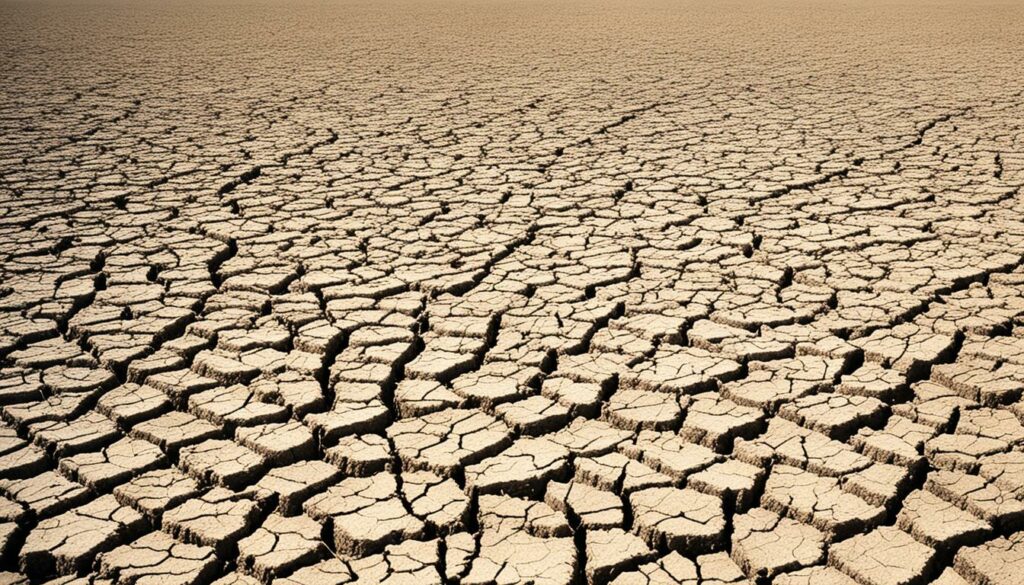
Heavy machines like tractors pack the soil down a lot. This is because they push the soil particles together with their weight. Livestock walking in the same places does this too. Bad soil cover and not changing crops often also lead to soil being more easily compressed.
Thankfully, farmers have ways to fight soil compaction. Changing the path of machines can spread the weight better, causing less harm. Using tyres with low pressure is another good practice. These steps help lower the pressure on the soil.
Planting crops with deep roots also breaks up the soil, making it healthier for plants and water to move through. Soil aeration, done with care through tillage, can help a lot too. Using tools to loosen the soil can make it less compacted by 0.15 g/cm3. Adding organic matter like compost reduces compaction as well, improving soil for plant roots.
Below is a table that shows how different methods can reduce soil compaction:
| Compaction Alleviation Technique | Effectiveness (Bulk Density Reduction) |
|---|---|
| Compost Amendments | 0.25 to 0.35 g/cm3 |
| Tillage | 0.00 to 0.02 g/cm3 |
| Specialised Soil Loosening | 0.05 to 0.15 g/cm3 |
| Reforestation Activities | 0.25 to 0.35 g/cm3 |
Improving soil aeration and structure has many benefits. It helps with compaction and boosts soil health. By using different tools and methods, we can make our soil more productive. As we learn more, we find better ways to keep our soil healthy.
The soil microbiome is a group of small organisms like bacteria and fungi. It’s very important for the health of the ground. These tiny beings help the soil get better and are key for many important natural processes.
Many microorganisms live in the soil and do amazing things. They break down dead plants, recycle nutrients, and keep diseases at bay. Bacteria and fungi change old leaves into compost. This makes food for plants.
Actinobacteria eat hard cellulose and make a shield for plants against diseases. Fungi also build networks that help with getting more nutrients and making the soil stronger.
The health of the soil depends a lot on these small creatures. Yet, over half the good soil microbes in many farms are asleep because they lack food. So, it’s vital to keep their environment good for them to work. If we do this, the soil and plants will be healthier and fight off diseases better.
Animals like earthworms also help keep the soil good by moving nutrients around and making the ground less hard. They show just how important it is to have a lot of healthy microorganisms.
| Indicator | Implications |
|---|---|
| Soil Bacterial and Fungal Activity | Enhanced decomposition, nutrient cycling, and disease suppression |
| Beneficial Microbes for Soil Enhancement | Improved plant growth, resilience against pathogens |
| Microbial Ecology Importance | Crucial for maintaining balanced soil ecosystems |
A strong soil microbiome is key to better soil and plant growth. We need to watch out for things like bad soil pH and too hard soil. These can hurt the good work of the soil’s tiny residents.
Measuring soil health means looking at many signs to understand how good the soil is. Healthy soil does a lot: it helps with water and nutrient movement, boosts crop growth, supports plant roots, and stops pollution. These signs come in chemical, physical, and biological forms.
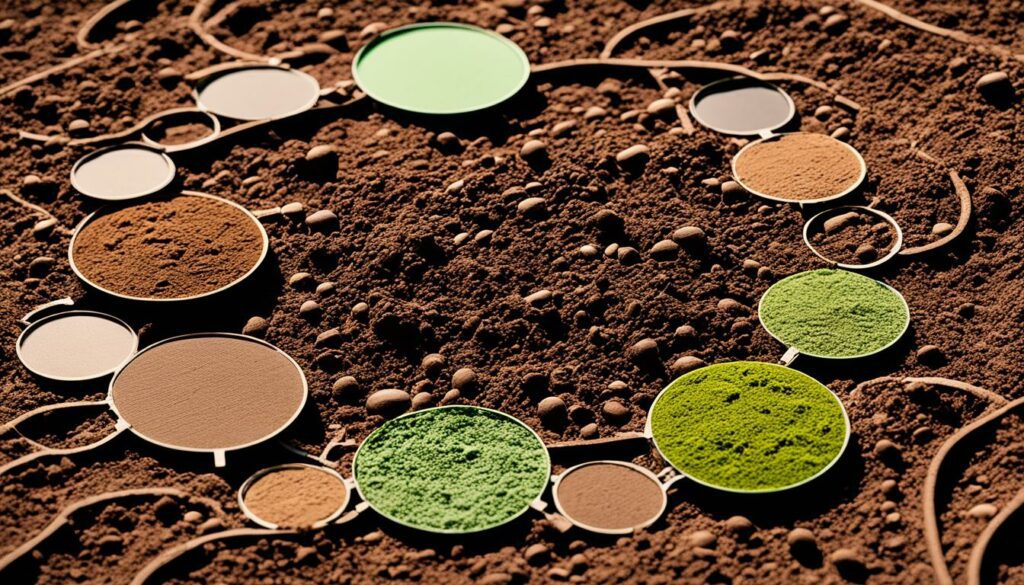
We check soil by looking and testing. Things like soil pH and nutrients affect plants and microorganisms in the soil. How well soil holds water and lets it in also points to its health. Healthy soils let roots move easily and show good structure through aggregates and water absorption.
Glowers need easy ways to check soil health. Things like how much soil is covered, its colour, and if there’s life like earthworms are good signs. The smell of geosmin, from active bacteria, means the soil is biologically healthy. Geosmin gives off an earthy smell showing rich life in the soil.
Some checks need special tools for things like carbon, soil food for plants, and how water goes through. Besides these, seeing organic carbon, nitrogen levels, and water movement in soil gives a deep look at soil health.
Here’s a simple table for growers to understand the main signs of soil health:
| Indicator | Significance |
|---|---|
| Soil Cover | Prevents erosion and retains moisture |
| Soil Colour | Darker soils indicate higher organic matter |
| Earthworm Presence | Indicates biological activity and good soil structure |
| Geosmin Odour | Suggests active microbial content |
| Organic Carbon Content | Vital for soil fertility and structure |
| Nitrogen Mineralisation | Essential for nutrient cycling and plant growth |
| Infiltration Rate | Indicates soil’s capacity to absorb water |
Soil health is vital for farming success, greatly affecting how well crops grow. To really see how soil health and yield are connected, we look at the soil’s physical and living aspects.
Experts agree that when soils are healthy, we get more crops. This is seen through things like earthworm numbers and how the soil looks. These tests prove there’s a clear link between soil health and bigger harvests.
When we measure things like soil density or the amount of nutrients, we learn more about how good soil is for growth. Long tests have shown that good soil, with enough organic matter and the right nutrients, leads to better harvests. A method called the Comprehensive Assessment of Soil Health also shows better soil means more crops, like corn.
To get more crops, we need to make the soil healthier. We can do this by:
A key study found that having different crops and using natural fertilisers can really increase yield. Knowing how different soil health tests turn out helps farmers make smart choices. This ensures their land keeps producing well over time.
To end, it’s clear that good soil means more crops. By focusing on soil health, farmers can see better harvests right away and continue to do well in the future.
| Soil Health Parameter | Impact on Yield |
|---|---|
| Bulk Density | Higher soil bulk density can restrict root growth, reducing yield. |
| Macroporosity | Increased macroporosity enhances water infiltration and root aeration, boosting yield. |
| pH Level | Optimal pH levels improve nutrient availability, leading to higher crop yield. |
| Soil Organic Matter (SOM) | Higher SOM supports better nutrient availability and improved soil structure, increasing yield. |
| Earthworm Counts | High earthworm activity indicates good soil structure and fertility, enhancing yield. |
Soil health indicators tell us a lot about soil’s health and its ability to support life. They include things like pH, carbon, nitrogen, and some metal levels, among others. By looking at these things together, we can understand the health of soil. This helps us know if the soil is good for growing plants or supporting the environment.
But, we still need more information. There’s not enough about the tiny life forms in the soil and how strong the soil is physically. New technology in studying genes could help with this, giving us a closer look at the soil’s living world. Adding worms and other small creatures as signs of soil health might make checking soil on farms better. There are also new tests that might help us know more about the soil’s physical strength.
We should look at soil in more ways than we do now. It’s not just important for producing food. Soil has value on its own and in how it supports life. There are simple ways, like looking at the soil with your eyes, that can give us clues about soil health. This helps farmers and people who look after the land. Focusing on using the land in a smart and caring way can keep our soils healthy. It’s crucial for the future of our environment. Click here to find out more about good ways to farm and take care of the soil.
Soil health indicators help us understand soil quality. They look at the soil’s physical, chemical, and biological parts. These measures show how well soil works for growing crops, handling water, and supporting life.
Soil structure is about how soil particles stick together. It affects how water and air move through the ground. Good structure helps keep water, supports plant roots, and allows microbes to do their job.
Soil pH is a measure of soil’s acidity. It really impacts what plants can take up from the soil. Wrong pH levels can stop plants from getting the food they need to grow well.
Soil organic matter is key for a healthy soil. It stores nutrients, improves structure, keeps water, and feeds soil life. More organic matter makes soil better for plants and all living things.
Microbes are very important for good soil. They help recycle nutrients, store carbon, and fight disease. Having many different kinds of active microbes means the soil is rich and plants grow well.
Nitrogen, phosphorus, and potassium are the big nutrients plants need. They help plants grow strong. It’s important to keep these nutrients at the right levels for soil to be fertile.
Soil salinity shows how many salt there is in the soil. Too much salt is bad for plants. It can make it hard for them to get enough water. Keeping salt levels low is important for soil health.
Preventing soil compaction is about how we farm. It’s good to use machines carefully, pick the right tyres, and grow plants with deep roots. These things help keep the soil fluffy, helping roots and microbes.
Soil colour tells us a lot about the soil. It shows if there’s lots of organic matter and if water can drain well. Dark soils often have more organic matter. Scientists use the Munsell system to look at soil colours.
Soil erosion steals the top layer of soil. This is very bad for farming. To stop this, we can keep the ground covered, use special areas by fields, and follow the land’s shape for planting. These steps keep the best soil from washing away and keep the ground healthy.
Farmers can check soil health by looking at its cover, colour, feel, and life. They might also send samples to labs to check the carbon and nitrogen levels. Knowing about these things helps farmers take good care of their soil.